With a medallion in the center, Antique Rose Medallion china is a well-known Chinese export porcelain variety painted in green, pastel pink, gold, yellow, red, and blue. Take note that the focal bloom is not a rose but the stunning peony, which is the national flower of China. Birds, butterflies, trees, and normally people sitting out at court are usually all around it.
For purchasers in America and Europe, the first pieces were available for purchase in the 1850s. As a result, you may find them throughout Western interior design, including on plates, vases, and saucers, and distinguish the subtle changes between different rose patterns.
Throughout the 19th and 20th centuries, Chinese porcelain known as antique Rose Medallion china was a prominent import. Even today, it is simple to find this vividly colored and very decorative china, which ranges in price from the incredibly cheap to the eye-wateringly expensive.
Table of Contents
Antique Rose Medallion China History
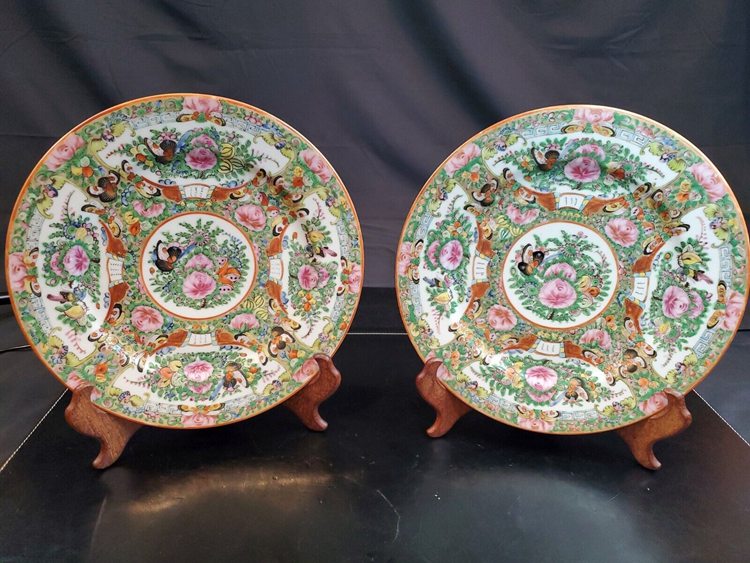
China and the West traded silk and tea before the Rose Medallion was created. After mounting it with silver and gilding it, the Chinese began exporting their expensive porcelain to Europe in the fifteenth century.
Early in the 16th century, Chinese potters started making porcelain expressly for the Western market. By the end of the 17th century, little had altered from the customary blue on white design.
Chinese makers modified porcelain designs, styles, and shapes in the late 18th century to suit the likes of Europeans and Americans. Rose Medallion, one of the fresh styles, first debuted in the 1830s. It’s interesting that it’s still in use and widespread.
Chinese export porcelain that was hand-painted in the beginning was exquisite, had intriguing intricacies and distinct lines, and was a little heavier than subsequent versions. Unfortunately, higher demand frequently resulted in lower quality, and only the best products had the desired rough underlying surface.
In addition to quality, markings on the reverse of each item make it easy to determine its age. Before 1890, porcelain was produced without a mark, and between 1890 and 1920, the word CHINA was stamped on each piece.
The Made in China logo is still there on brand-new items. Porcelain items with the Manufactured in Hong Kong logo should be handled with caution as they are not considered antiques.
What is Famille-Rose Porcelain?
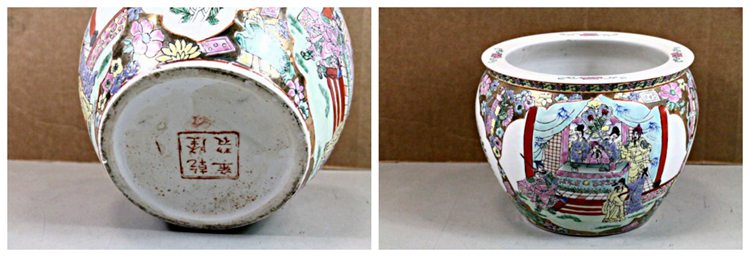
Decorative and everyday porcelain objects that are primarily pink are referred to as Famille-Rose Porcelain. These artifacts were frequently embellished by artisans using colorful enamel made from colloidal gold.
In the early 18th century, during the late Kangxi dynasty, Chinese people first used this style of decorating. Consequently, FENCAI was the first Chinese name for Famille Rose porcelain.
No one else was able to pinpoint exactly how this enamel arrived in China or when craftsmen started using it. According to one theory, Jesuits introduced it to China after Andreas Cassius of Leyden created it in the 17th century.
Origin of Chinese Porcelain
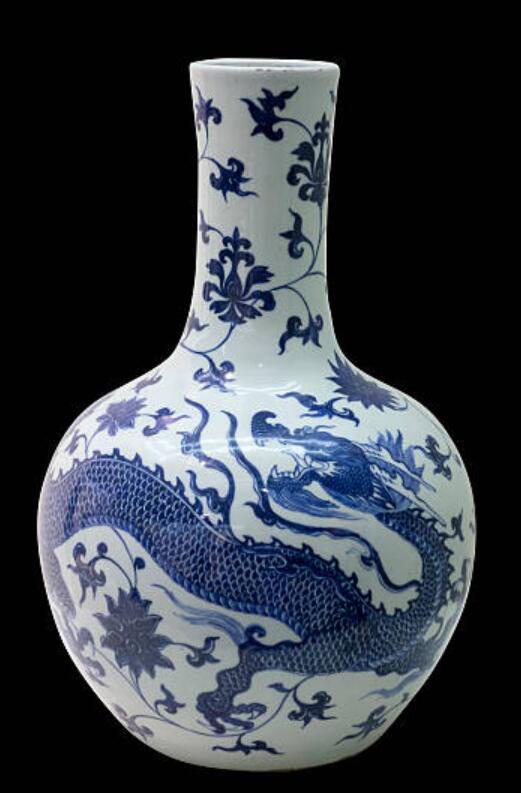
Before The Chinese Rose Medallion became well-known, China’s trade with the western frontiers consisted primarily of silk and tea.
Chinese porcelain began to be exported in the 15th century, and it was mostly produced in silver and gilded pieces for the European populace.
Chinese potters began creating porcelain with the distinctive blue and white pattern from the beginning of the 16th century, primarily catering to the desires of the West. The 17th century saw no change in this pattern.
Late in the 18th century, the Chinese porcelain industry began to develop, and new, contemporary designs, patterns, and styles emerged that were better suited to the Western market.
The Rose Medallion was one of these fresh styles. This specific style became well-liked and is still in demand today!
Techniques of Porcelain Production
As for the porcelain itself, its main component was kaolin, a mineral made from crushed granite. It gave off its shine, translucence, toughness, and endurance.
It took a lot of effort to crush the rock into white powder. The following stage was to combine it with water to create the finished product, clay. The intricate process of making lamps, platters, jugs, jars, jugs, and bowls couldn’t begin until after that.
The majority of them researched for several years before developing a high level of precision in their masterpieces. They then heated each item in a high-temperature firing until the clay vitrified.
At this step, the so-called bisque fired was the finished product (biscuit form). Each piece was meticulously painted by artisans after glazing to achieve the ideal Famille Rose pattern.
Types of Famille Rose Porcelain
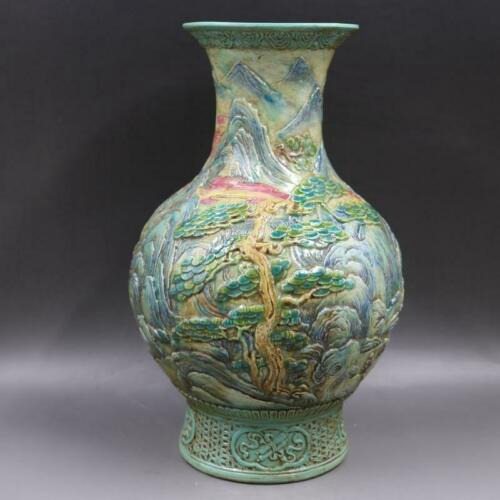
The name Famille Rose (also known as the rose family) refers to a variety of distinct patterns and related designs, yet each of these patterns has distinct characteristics.
It is important to note that the color pink is prominently used in each of these patterns.
The Morehouse family started making Famille Rose china porcelain in the 1720s, and it quickly gained popularity at the Imperial court under the Yongzheng and Qianlong dynasties. Three classifications of Famille Rose China Porcelain were available:
-
Rose Medallion
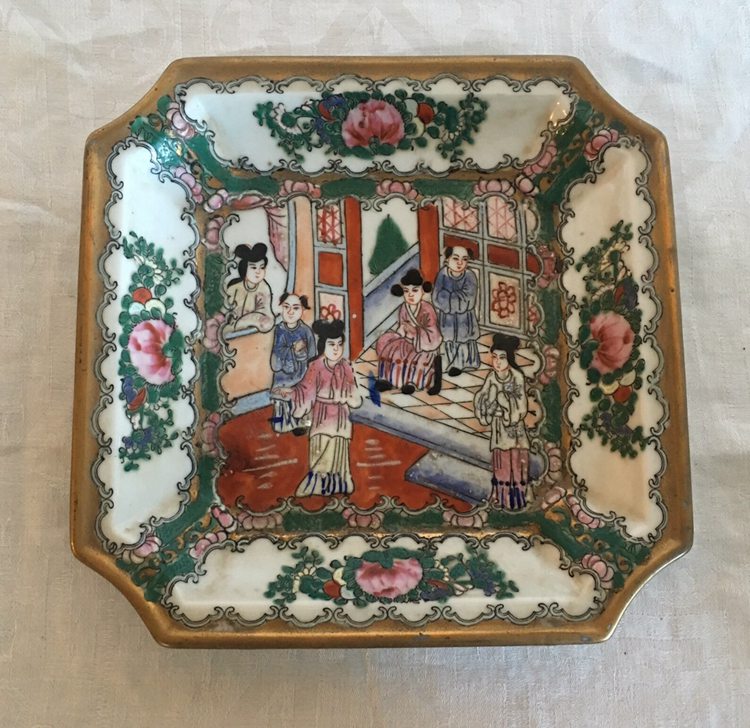
The early rose export design was the central medallion-adorned Rose Medallion pattern type. With bursts of orange, yellow, blue, and blue, delicate pink and pastel green are the dominant hues. There are several objects with this design, such as:
- Tureens and baskets
- Serving dishes
- Teapots and vases
- Bowls and cups
- Basins, creamers, and soap dishes
- Serving trays and plates
The medallion had a peony or a bird, and it was surrounded by panels with images of family or court situations that were embellished with insects, flora, butterflies, fishes, and fruits. In fact, it was a wonderful blend of roses from both Rose Canton and Rose Mandarin.
The most widely used and recognizable porcelain in the West was Rose Medallion. Presidents Gerald R. Ford, Ulysses S. Grant, and James Buchanan were among the notable Americans who favored this style of pottery.
-
Rose Mandarin
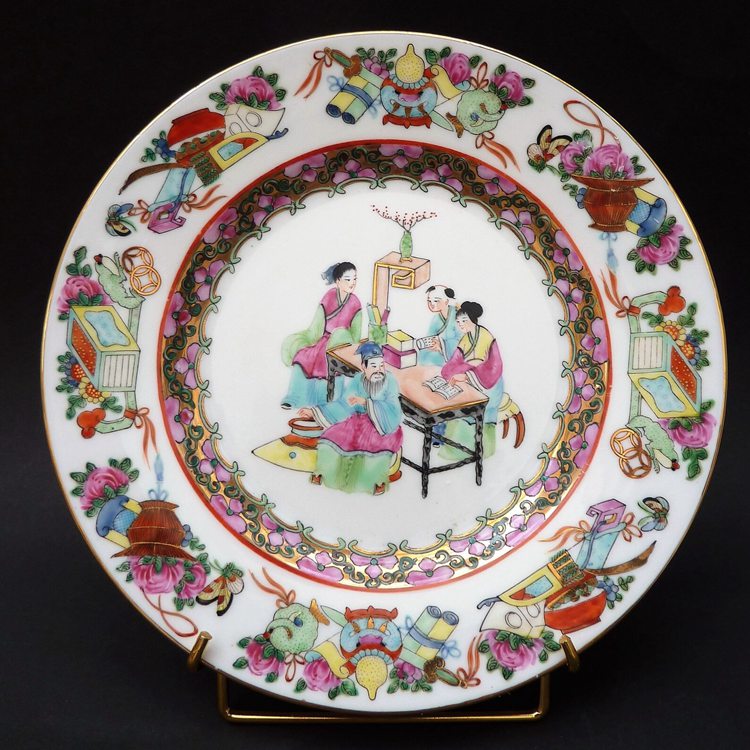
Rose Mandarin painted leisurely sceneries in both household and formal settings. It was an uncommon pattern devoid of birds.
-
Rose Canton
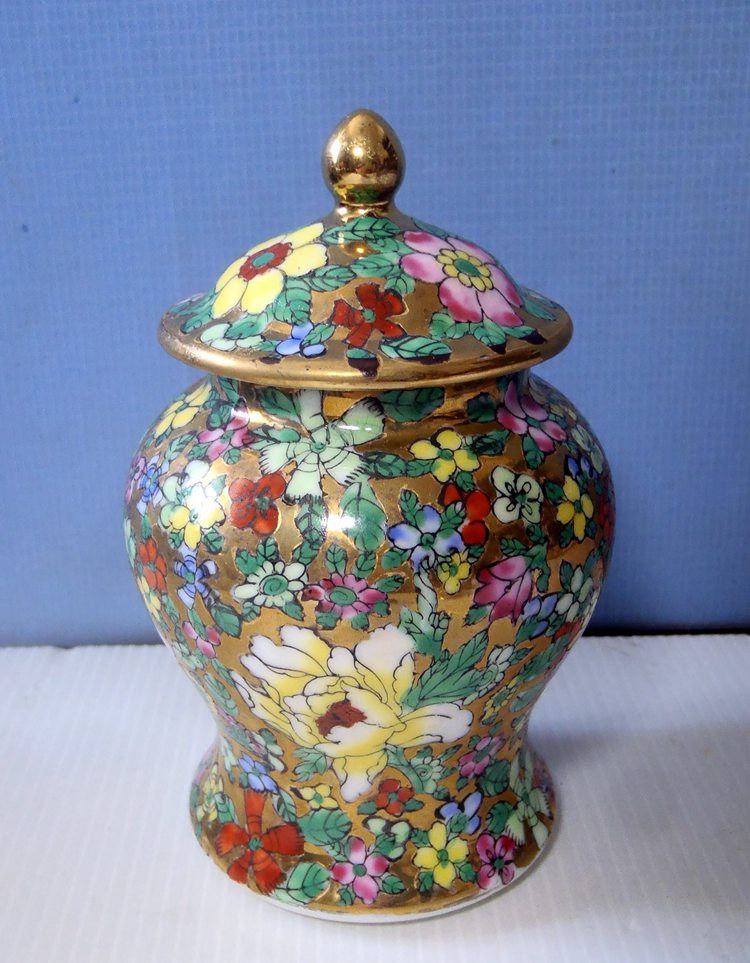
The third sub-category was Rose Canton, which had no humans but had butterflies, bugs, butterflies, flowers, birds (mostly magpies), and crickets. The design layout showed either a free arrangement or panels.
-
Mille butterflies
The design, known as mille butterflies, included a core with whirling black and yellow butterflies and a border with flowers and butterflies.
-
Garden
The frontal landscape of this design featured flowering trees, birds, and butterflies.
-
Mystical bird with flowers
This 19th-century design featured a jumble of long-tailed birds, flowers, butterflies, and insects. The same themes would occasionally join together in smaller numbers.
-
Bouquet
A central floral bouquet with bows and ribbons was used in the late 19th-century design.
-
Bok Choi
These distinctive works from the late 19th century, known as cabbage leaves (Bok Choi), are easily recognizable. They had a medallion in the center with a Chinese emblem encircled by butterflies and green cabbage.
How to Identify Antique Rose Medallion China?
(YouTube link https://www.youtube.com/watch?v=XDrTHt6f20o )
There are no recognizable lettering or Chinese characters on the bases of the first antique Rose Medallion china pieces, which date to circa 1850. Additionally, compared to later porcelain, this early variety has more pitting, a possible gold rim, and generally cleaner painting.
The term “China” will be printed on the bottom of Rose Medallion china created between 1890 and roughly 1915, while “Made in China” will be printed on china made after 1915. Items marked “Made in Hong Kong” or with Chinese inscription on the bottom are not regarded as antiques.
Features of a Rose Medallion
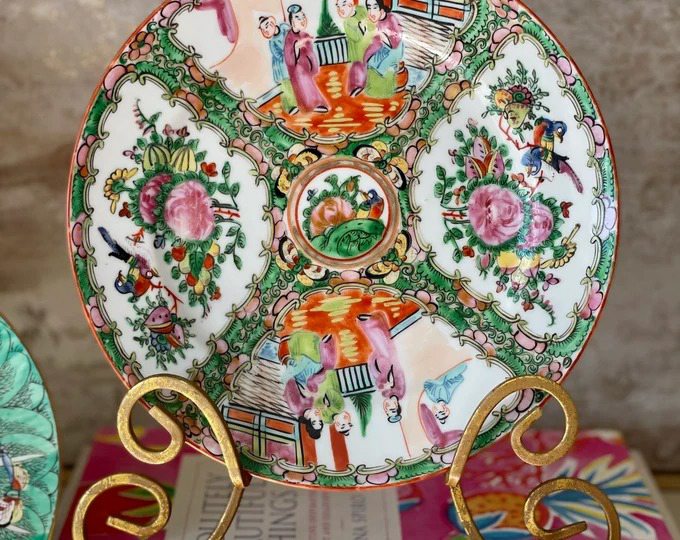
Because “practice makes a man perfect,” handling Chinese porcelain frequently will increase your awareness of its subtleties and features.
You can accurately identify an antique piece by looking at these features.
Beginners could learn more about the past of artifacts by going to auctions, speaking with experts, and visiting museums.
To identify an antique piece, one needs be mindful of the following significant features:
-
Specifications
The elaborate patterns on antique Rose Medallion china included multifaceted borders and multiple delicate painting layers in the center. Unfortunately, the 19th century saw a reduction in such complexity, which lessened the beauty of the contemporary pieces.
In those early goods, you might see finely detailed drawings of birds as well as people’s features and attire. Hand-painted birds included golden accents, clearly defined fur, and extended tails, and female models frequently had gilded outlines in their hair.
-
Age
Except for a piece having provenances that can be verified, it is impossible to pinpoint a specific porcelain age. So, it’s OK to accept time periods like the middle to the end of the 19th century.
-
Colour
The fact that orange wasn’t the main color was evident in the figural scenes’ feet, rims, and small details on the tops of bird and butterfly wings. Its hue has evolved over time, becoming more reddish.
-
Shape
Early in the 1800s, Chinese export porcelain was very strong and substantial, but it gradually got lighter. Additionally, to accommodate Western tastes, manufacturers created new item shapes. They consequently began making dinnerware such as teapots, soup boats, and pitchers.
-
Manufacturer Marks or Stamps
Early Chinese export porcelain, was unmarked. However, as a result of the McKinley Tariff Act of 1890’s requirement that all imported goods be marked, products made after 1891 featured the red CHINA mark on their porcelain bottoms.
After 1919, products destined for the US market received the MADE IN CHINA label. However, those that were sent to Europe lacked any markings at all.
Be aware that neither marks nor their absence determines the age or quality of China porcelain. Marks are frequently filed off or altered throughout time, and occasionally you’ll see a dynasty mark as a tribute to a favorite ruler.
Atypical marks should be avoided because contemporary items made in the 20th century have various stamps. For example, you can notice:
-
ACF or YT marks
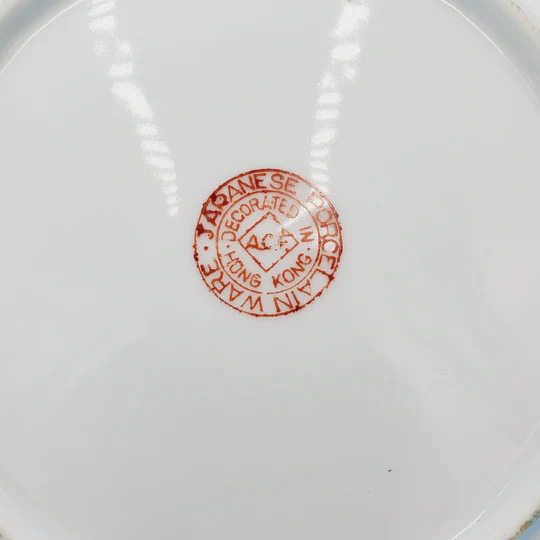
These markings indicate that while decoration, artwork, and glazing finished in Hong Kong, porcelain production was carried out in Japan.
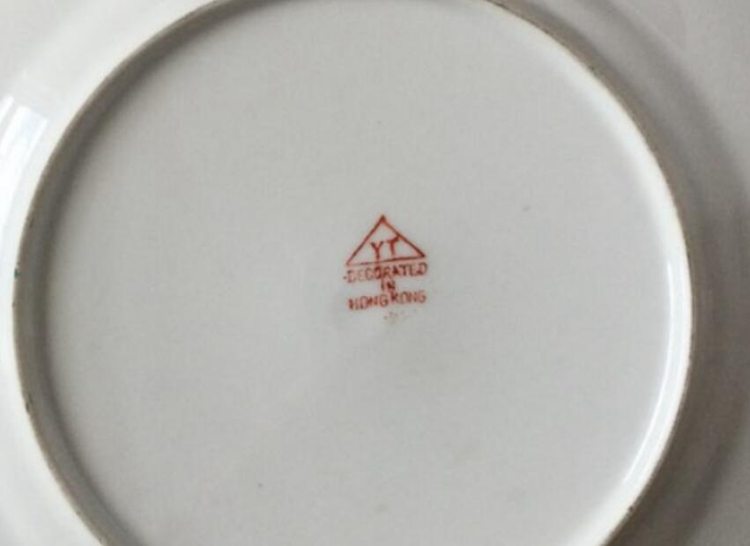
The high demand for this particular type of porcelain from the 1960s to the 1980s was the driving force behind this combination. Workshops were unable to produce enough goods; therefore, they were compelled to import Japanese porcelain to fill the gap.
-
Macau
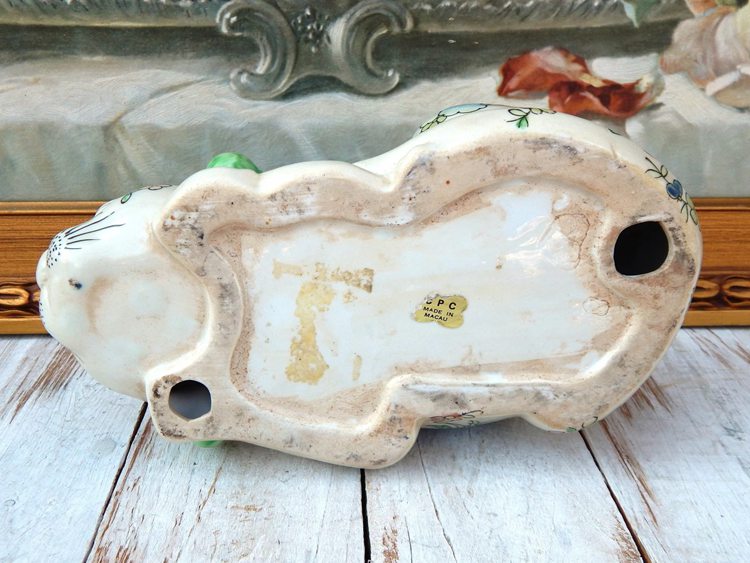
Cheap enameled porcelain products from Macau bore the label MADE IN MACAU on the bottom. These items were made elsewhere, but artisans in Macau just embellished them by adding a paper mark or writing a marking in enamel.
Chinese and Macau porcelain might be distinguished from one another because the former had opaque or foggy enamels. Additionally, not all of the decoration was done in a Chinese manner.
-
Symbolic Illustrations
Each artwork that was painted on fine china porcelain has a particular symbolic meaning. Consider this:
- Butterflies– Butterflies represented social contentment, fidelity, and unconditional love.
- Crickets– A battling spirit was represented by crickets.
- Magpies– Magpies were birds that brought people joy.
- Peonies– Peonies, the national flower of China, were symbols of beauty and pageantry.
- Dragons– Dragons were a symbol of the monarch and stood for joy, strength, and rebirth.
Value of Antique Rose Medallion China
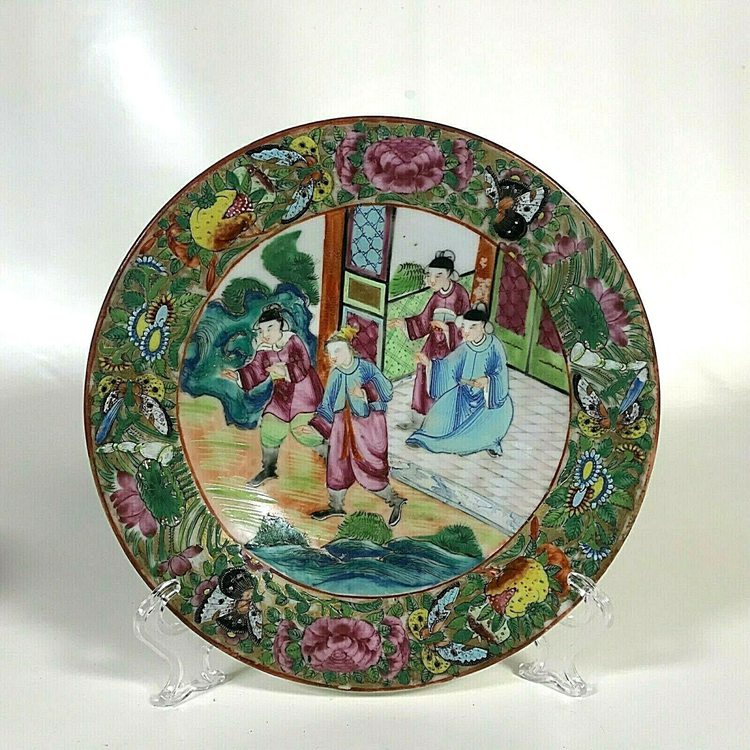
Unsurprisingly, the most valuable Rose Medallion pieces are those that are the oldest and finest made; some of them have prices that go into the tens of thousands of dollars. One pair of huge Rose Medallion vases from the 19th century, for instance, are sold for about $18,500, and a sizable Rose Medallion punch bowl from the 1870s is listed for approximately $7,000, respectively. However, if you look for smaller items like teacups and saucers as well as more contemporary pieces from the early 20th century, you can find Rose Medallion china that even the casual collector can buy. Consider this octagonal Rose Medallion saucer and cup which is only being offered for roughly $100 in a single online auction.
List of Sold Antique Rose Medallion China
Following is a list of antique rose medallion china auctions, organized by type and price:
- Large 19th-century Chinese Rose Medallion vase – $10,949
- Pair of Rose Medallion porcelain candelabrum – $21,000 per set
- Large Pair of Chinese Rose Medallion vases – $6,993 per set
- Chinese Rose Medallion canton porcelain punch bowl – $12,600
- Chinese Canton Famille rose large center bowl – $26,800
- Chinese canton garden seat – $6,183
- Century petite hand-painted pair of Rose Medallion vases – $2,480 per set
- Chinese Rose Medallion punch bowl – $4,850
- Chinese Rose Medallion garden seat – $4,895
- Chinese Rose Medallion teapot – $1,225
- Century hand-painted Rose Medallion oval platter – $1,480
- Century petite hand-painted pair of Rose Medallion vases – $2,480 per set
- Chinese Rose Medallion scalloped serving bowl – $950
- Pair of Chinese Rose Medallion teacups – $500 per set
- Chinese Rose Medallion porcelain tureen – $675
- The 1950s Chinese Rose Medallion porcelain dinner plate – $120
- Chinese Rose Medallion plate – $100
- Chinese porcelain Rose Medallion tea set – $34
- Chinese Rose Medallion bread plate – $50
Guidelines on Recognizing a Reproduction
Alas, some dishonest marketers do attempt to sell Chinese porcelain that is either contemporary or a replica as being old. There’s no way that you’ll be duped, though, if you consider a few certain qualities while evaluating a potential transaction, particularly if you’re purchasing online or from a new seller:
-
Examine the finishing
Examine the finishing or gilding for any scratch marks that may have been added to recently painted gilding to give the illusion that the piece is older than it actually is.
-
Inspect the labels
Some sellers will try to remove the labels “China” or “Made in China” to make a piece look antique. As a result, you should check for any gouges on the bottom of a pieces where these marks would typically be.
-
Examine the colours
It’s crucial to pay close attention to the pieces’ color vibrancy because this might be a revealing indicator of whether they are indeed older than the seller claims. Oranges on Rose Medallion porcelain pieces from the middle of the 19th century, for example, will become rusty instead of vivid and dazzling with time because orange pigments fade.
Buying Guide for Rose Medallion China
You must first become informed with the antique products on the market and the prices they are being offered at.
Starting with eBay auctions is an excellent idea because you can observe from the finished auctions what kinds of items are sold and how much they cost.
You can choose from a range of porcelains by using different word combinations, such as a rose medallion, rose medallion china, and rose china.
When you finally locate something you like, you should run a second search on a search engine to learn more about it.
Most people associate porcelain items of this type with more affordable options. Consequently, there is a great chance that they are unaware of its true worth!
Always make an effort to haggle over the price. You never know; you might score a deal!
Where to buy these Antique Rose Medallion China Online?
Searching online is your best option if you need to find one immediately. Consider the following sites:
- e-Bay– The Antique Rose Medallion China of your dreams can be easily found on eBay, one of the greatest sites to find beautiful Antique collectibles. It’s also ideal if you’re considering selling because they provide a very user-friendly e-commerce feature and can reach a sizable global audience.
- Ruby Lane– Since their auction stream is sourced via more conventional methods, Ruby Lane is, it must be said, a little more constrained in the number of Antique Rose Medallion China that are offered at once. It’s a good idea to constantly checking their inventory, though, as they are one of the biggest online auction houses, to see if they have what you’re searching for posted.
- Etsy– Since people frequently discover these different Vintage Rose Medallion China in their grandparents’ homes across the nation, internet marketplaces like Etsy are among the greatest places to find a ton of these pieces on sale.
Summary
An antique variety of porcelain known as “rose medallion china” has a central medallion with the peony, the nation’s national flower, surrounded by people, trees, birds, and butterflies.
The most common name for it is Rose Medallion porcelain. Rose Canton can also be recognized without people in addition to Rose Mandarin with people.
Chinese porcelain is a means to recognize a long-standing custom and preserve the art and craftsmanship involved in its creation, whether you choose to collect it or use it to bring a touch of elegance to your home.
When you can purchase elegant antique Rose Medallion China for just a few hundred dollars, you don’t need thousands of dollars to purchase a Ming Dynasty vase.
Frequently Asked Questions
-
Do my Antique China Dishes have any Value?
Some collectors may find value in blue and white china bowls. The floral patterns, designs, and styles determine the value of other components.
They can also be sold as modern vintage items for a decent price if they’re in good shape.
-
Are Rose Medallions still manufactured?
Rose Medallions are still produced today, however collectors don’t really value the newest models.
-
How much is the Rose Medallion worth?
One pair of sizable Rose Medallion vases from the 19th century, for instance, are sold for about $18,500, and a sizable Rose Medallion punch bowl from the 1870s is listed for approximately $7,000, respectively.
-
What identifies a family rose?
Due to the opaque glass, famille-rose and enamel both develop lovely colors.
There are several guidelines for identifying the two varieties of porcelain.
- In comparison to famille-rose, enamel is more colorful.
- Layers of paint are used to create the enamel designs.
- While the famille-rose is delicate, the enamel is vivid.
Our Takeaway
If you recently purchased or are considering buying an antique Rose Medallion China. Or perhaps you found a Rose Medallion China in the basement of the new estate. Whatever the situation, you can find out how much a Vintage Rose Medallion China is worth by using our guide on identifying and appraising them. However, we strongly advise you to visit a professional appraiser if you want to fully understand the worth and value of your antique Rose Medallion China.

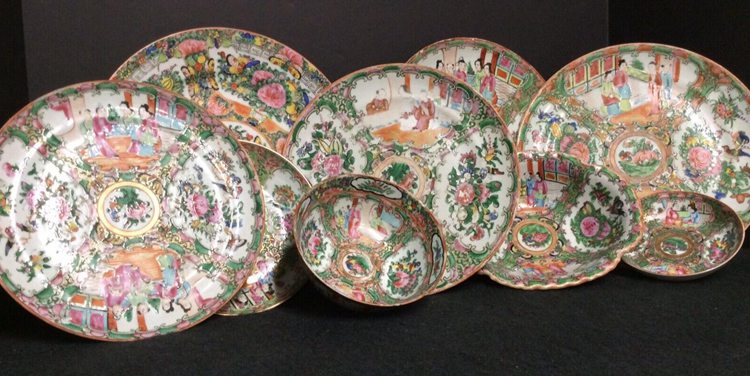
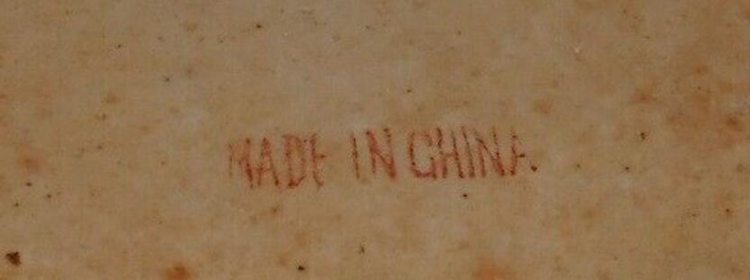




![Where To Sell Antique Furniture In 2022 [Ultimate Guide]](https://www.jacquelinestallone.com/wp-content/uploads/2022/09/Etsy-Your-Place-To-Buy-And-Sell-All-Things-Handmade-600x450.jpg)


